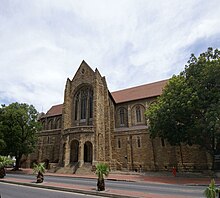St. George's Cathedral, Cape Town
| St George's Cathedral | |
|---|---|
| Cathedral And Metropolitical Church of Saint George the Martyr | |

St. George's Cathedral, north transept.
|
|
| Country | Cape Town, South Africa |
| Denomination | Anglican Church of Southern Africa |
| Churchmanship | Anglo Catholic |
| History | |
| Founded | 22 August 1901 |
| Dedication | St. George |
| Past bishop(s) |
Desmond Tutu Robert Gray |
| Architecture | |
| Status | Cathedral |
| Functional status | Active |
| Heritage designation | Provincial Heritage Site |
| Architect(s) | Herbert Baker |
| Architectural type | Gothic |
| Style | Gothic |
| Specifications | |
| Bells | 10 Bells (Change ringing) |
| Administration | |
| Parish | Parish of Cape Town |
| Archdeaconry | Cathedral |
| Archdiocese | Cape Town |
| Province | Southern Africa |
| Clergy | |
| Archbishop | Thabo Makgoba, Archbishop of Cape Town |
| Bishop(s) | Garth Counsell, Bishop of Table Bay |
| Vicar(s) | Mlamli Mfenyana |
| Dean | Michael Weeder, Dean Of Cape Town |
| Canon Missioner | Neil-Alan Walsh |
| Assistant priest(s) | Mxolisi Sotshononda |
| Laity | |
| Organist(s) | Grant Bresler |
| Verger | Eddie Esau |
St George's Cathedral (in full, The Cathedral Church of St George the Martyr) is the Anglican cathedral in Cape Town, South Africa. It is the seat of the Archbishop of Cape Town.St George’s Cathedral is both the church of the Anglican Church of Southern Africa and a congregation in the Diocese of Cape Town.
The cathedral was designed by Sir Herbert Baker and the foundation stone was laid in 1901. The cathedral replaced a church built in 1834 on the same site, and is still incomplete.
In October 1827, the Bishop of Calcutta, on a visit to Cape Town which was, at the time, a distant outpost of his diocese, discussed the building of an Anglican church. Up until that time the Anglican community had used the Cape Town Castle for services, later being offered hospitality by the Groote Kerk. The colonial government donated a site at the lower end of the Dutch East India Company's gardens at the corner of Government Avenue and Wale Street and the bishop consecrated the land. The foundation stone was laid by Governor Sir Lowry Cole on St. George's day 23 April 1830 and at the same time Erste Berg Dwars Street was renamed St. George's Street. The church was built from drawings by the architect John Skirrow based on W & H Inwood's Neo-Greek St. Pancras' Church in London. Losing heavily on the deal, Hermann Schutte was the building contractor. The cathedral cost estimated ₤16,000 to build. On 21 December 1834 that St. George's Church opened for services. Upon diplomat Edmund Roberts visit in 1834, George Hough was chaplain and the church had a capacity of 1,000 people with 300 seats for the poor.
...
Wikipedia
